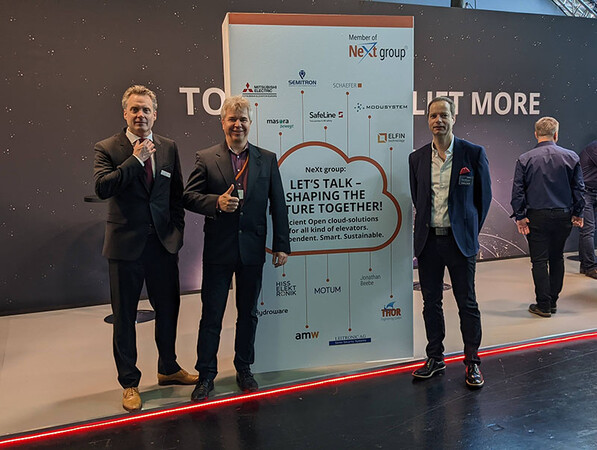Open standards for cloud communication
The moment when the CANopen-Lift standard became established in the lift sector at the beginning of the millennium was a milestone. This meant the different components of different manufacturers had now found a common language with which they could communicate with each other. But what happens when the data leave the lift?
This is where the NeXt group intends to offer a corresponding solution.
By Ulrike Lotze
In the beginning, the problem was that the number of components in the lift was increasing, and the question was how they could communicate with each other. This required a BUS system, but a standard for communication was also needed. This is no problem in proprietary systems. Everything speaks the same language in closed systems, but only the manufacturer themselves can offer components for them.
However, the language of the various manufacturers had to be standardised for the SMEs – this was the origin of CANopen-Lift. The SMEs in the lift sector would face enormous difficulties today without this standard, the members of the board of management of the so-called NeXt Group confidently declared.
And in a manner similar to the CAN in Automation (CiA) association, which represents the interests of CANopen, the NeXt Group would like to do this for the development and specification of open standards in communication with the cloud and for related open source projects in the international lift and escalator sector. But its ambitions are even greater, for not only interfaces can be standardised, but also hardware and software.
Publication before interlift 2023
It's about nothing more and nothing less than a piece of paper. The goal is a specification that defines and describes the rules of communication of a lift with the cloud. There is still a way to go. But the NeXt group intends to specify draft 1.0 by the end of 2022. Its goal is to publish it before interlift 2023, explained Geert Maurissen, Volker Hager and Jörg Hellmich.
The trio constitute the current board of management of the NeXt group. They have one task and one goal: they want to standardise communication outside the lift with other building technology systems in the same way as inside the lift. "The information is there, it just has to get out. That’s why we want to cooperate with all manufacturers."
Simplification for operators
 The Board of Directors of the NeXt group (from left to right): Volker Hager (Director Business Committee), Jörg Hellmich (Director Technical Committee) and Geert Maurissen (Chairman). Photo: © NeXt group
The Board of Directors of the NeXt group (from left to right): Volker Hager (Director Business Committee), Jörg Hellmich (Director Technical Committee) and Geert Maurissen (Chairman). Photo: © NeXt groupThis does not by any means convince all in the sector. This is because several component manufacturers had invested a lot in developing their own clouds in recent years and wanted to protect their business models through closed systems and not release their data, according to the assessment of the NeXt group board of management. But in their view what counted was not developing independent clouds – of which there were enough – but rather standardising communication with the cloud.
For the NeXt group, the advantages are obvious: despite different manufacturers, the market participants would then have a uniform data format in their lifts, which they could customise and offer new business models. Closed soft- and hardware that was tied to the manufacturer was not in the interests of the customers, since the many different systems involved a great deal of effort.
"We want to simplify things with our uniform open standard," emphasised Jörg Hellmich. And that would also be an advantage for component manufacturers, "The more compatible they are, the bigger their market, too."
Who can contribute?
The NeXt group wants to develop this open standard and introduce it to the standardisation committees in cooperation with the sector associations. But it was not just established to prepare the standard, but also to clarify questions: Who does the language belong to? Who can contribute? Can you change the solution? Who is liable if it includes errors?
The NeXt group, set up in 2017, has developed a set of rules for this purpose – in line with its motto: "If you believe in openness, if you believe in choice, if you believe in innovation from everyone. Then welcome to NeXt group."
What is the NeXt group? The NeXt group e.V. association, set up in February 2017, provides a platform for the development of open source hardware and software. The members of the NeXt group together develop specifications for different applications in the field of lifts and escalators. NeXt group e.V. offers a neutral platform for developing standardised components and interfaces – for lifts and escalators and promotes the image of standardised interfaces.
The association’s headquarters are in Germany. Currently, 17 companies are members in the NeXt group. The association has no full-time employees. The level of the membership contributions depends on the number of employees working in the lift segment of the company.
next-group.org

























Write a comment